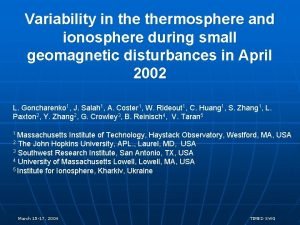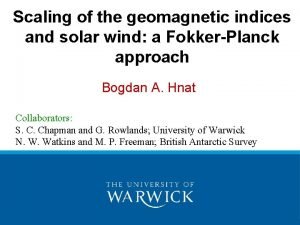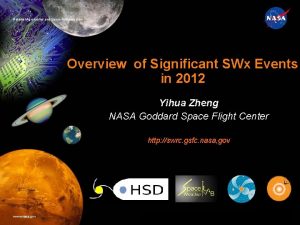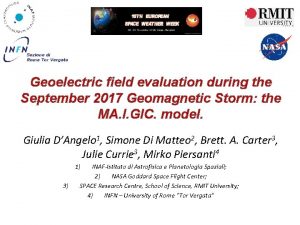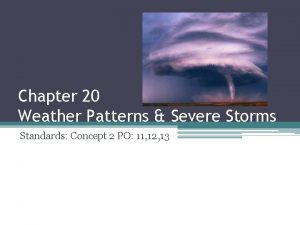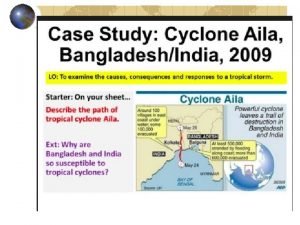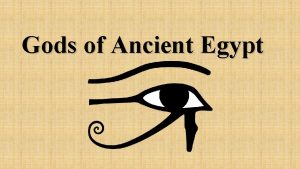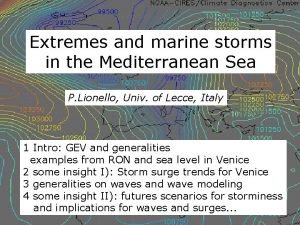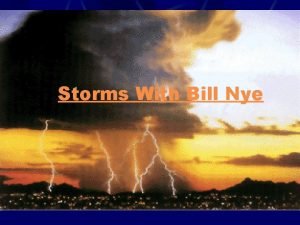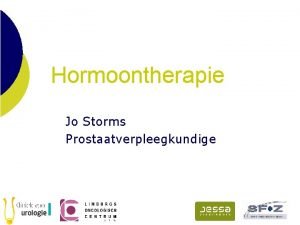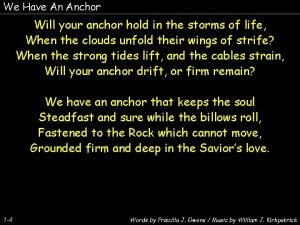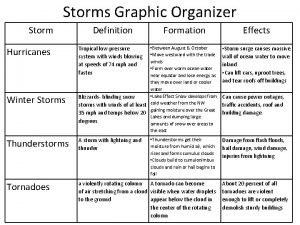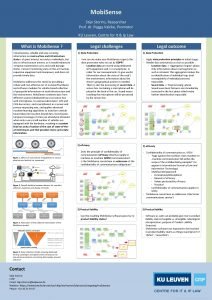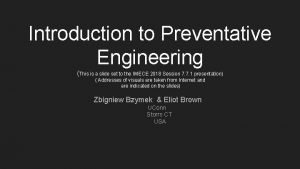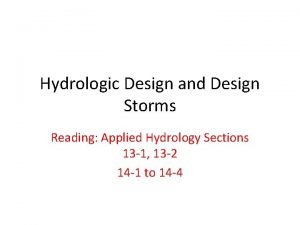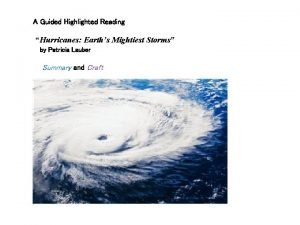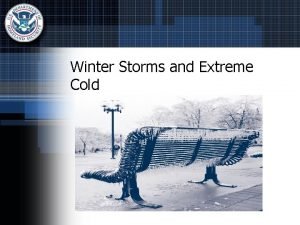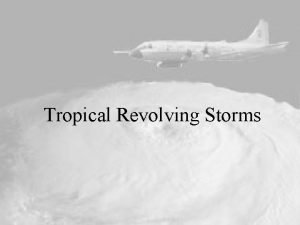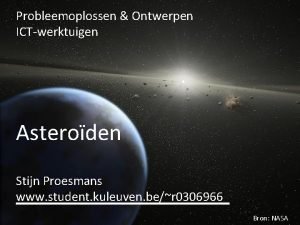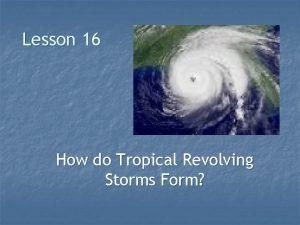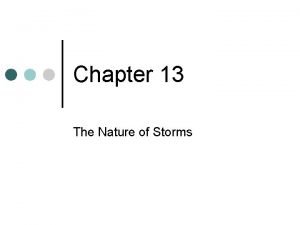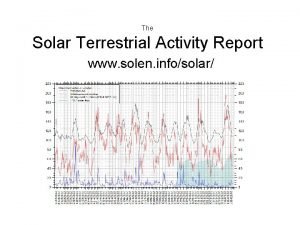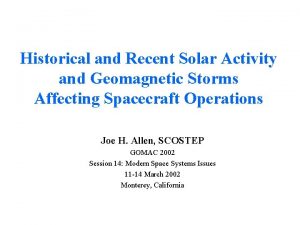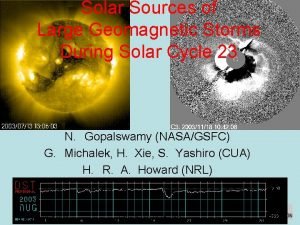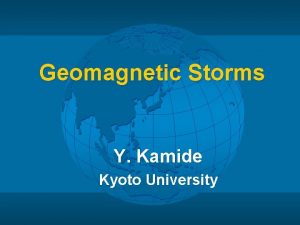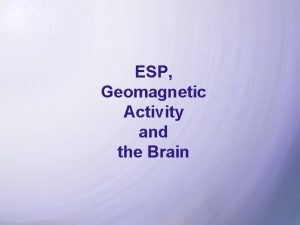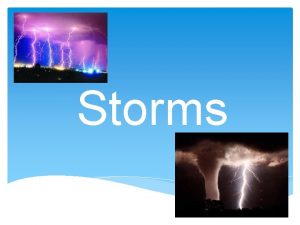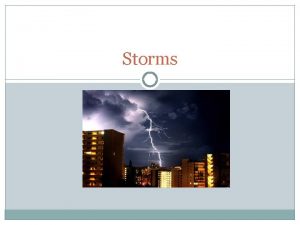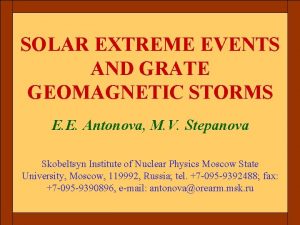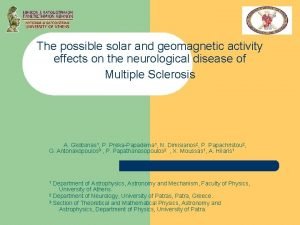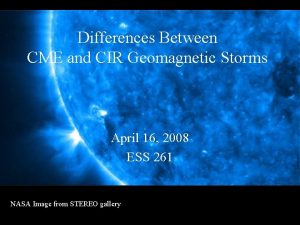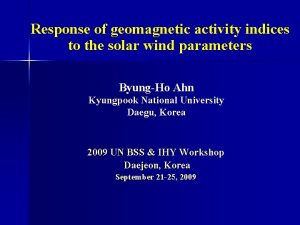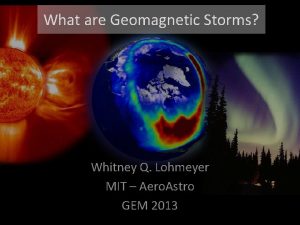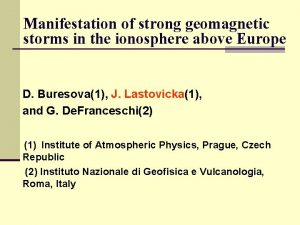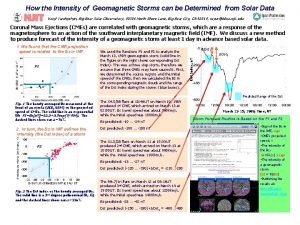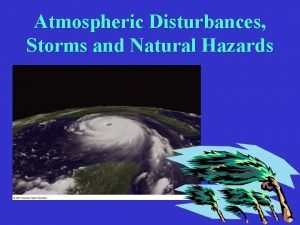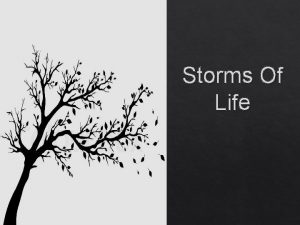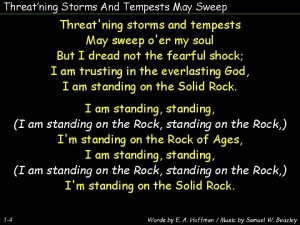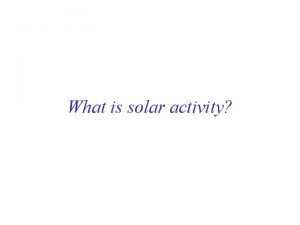Historical and Recent Solar Activity and Geomagnetic Storms










































- Slides: 42

Historical and Recent Solar Activity and Geomagnetic Storms Affecting Spacecraft Operations Joe H. Allen, SCOSTEP GOMAC 2002 Session 14: Modern Space Systems Issues 11 -14 March 2002 Monterey, California

(d) MPE disorientation (e) d. B/d. T tumbling (f) Optical disorientation (g) Power panel degradation

Major Magnetic Storms: 1932 -2000 Annual Sunspot Number: 1930 -2000

Total Number Of Storms Cumulative Monthly Magnetic Storms: 1932 -2001 Ap* > 40 160 140 120 100 80 60 40 20 0 Jan Feb Mar Apr May June July Aug Sept Oct Nov Dec


From C. Kunstadter

SAT-ND Timeline in-orbit failures in 2001 – P. C. Klanowski

SAT-ND Timeline in-orbit failures in 2000

SOHO-EIT, 2000/07/14 @ 07: 00 UT

Close-up from SOHO EIT Sensor Bastille Day 2000 Event (minutes later)

SOHO – EIT, 2000/07/14 @ 13: 28 UT


Maximum >10 Me. V flux = 24, 000 pfu, 4 th highest intensity event since 1976

Satellite Anomalies: 14 -16 July 2000 Proton Event & Geomagnetic Storm, Ap*=192 • ASCA (Advanced Satellite for Cosmology and Astrophysics) – lost attitude fix resulting in solar array misalignment and power loss, satellite probably lost (in P. C. Klanowski list). • GOES-8 & -10 – SEM Electron sensor problems, power panels • ACE (Advanced Composition Explorer) – Temporary SW and other sensor problems • WIND – Permanent (25%) loss of primary transmitter power & Temporary loss of Sun and star sensors • SOHO (also YOHKOH & TRACE) – High energy protons obscure solar imagery • GEO and LEO Satellites – S/C orientation problems during MPE • GEO Satellites lost ~0. 1 amp output from solar arrays

Satellite Anomalies at LEO South Atlantic Anomaly (SAA) & Auroral Zone Recent and Historical • • • TERRA-MISR 3 -16 Feb 2000 TERRA-SFE off 26 Oct 2000 TERRA-MODIS 15 June 2001, 03: 56 UT TOPEX 1992 -1998 NOAA-11 Sept 1988 - Aug 1990 STS-37, -39, -43, & -44 1991

TERRA – MISR Data Before Shutter Opening 3 -16 Feb 2000

TOPEX – 1992 -1998 and TERRA-MODIS 2001


COMPUTER ANOMALIES: STS-37, -39, -43, & -44 1991 Missions

Oct 2000 TERRA ECHOSTAR-IV Solar Activity in 2000 affects SUN Computers and Satellites

GEO ANOMALY TYPES • PHANTOM COMMANDS – surface charging, seasonal, orbit time dependent, 10 -50 Ke. V e • DEEP DIELECTRIC CHARGING – surface or interior, cycle dependent, > 2 Me. V e • SINGLE EVENT UPSET (SEU) – proton/ion event, > 10 Me. V p+ • LOSS of ORIENTATION – magnetopause crossing events, star bursts • POWER PANEL DEGRADATION – > 10 Me. V p+

GEO Communications Satellite Anomalies – J. Fennell (Aerospace) Early 1970’s

GOES-4 and – 5 Anomalies: Early 1980 s

10 – 15 Ke. V electrons drifting from midnight Farthing, Brown & Bryant, 1982 NASA Report


Deep Dielectric Charging-Arcing: Jan 1994 ANIK-E 1 & E 2

From Gordon Wrenn-1995

Single Event Upsets due to protons, alphas, heavier ions



Satellite Anomalies at GEO Recent and Historical • • • GALAXY-VII 13 June 1998 SCP-1 BRAZILSAT 09 April 2000 TWTA SOLIDARIDAD-I 27 Aug 2000 SCP ECHOSTAR-IV 31 Oct 2000 Transponders lost INSAT-2 B 4 Nov 2000 Service Outage GALAXY-VII* 22 Nov 2000 SCP-2 ECHOSTAR-VI ? April 2001 service GALAXY-IIIR 21 April 2001 SCP TELSTAR-6 22 April 2001 SCP

RECENT ACTIVE TIME 2 -11 April 2000 • High levels >2 Me. V electrons, 04/0212 except during storms • Proton event, 04/04 -06, 55 pfu • Large geomagnetic storm, Ap*=137, 04/06 -07 • Brazilsat-A 2 lost TWTA on 04/09


X M C Max pfu = 31, 700; 3 rd largest since 1976 INSAT 2 B GALAXY-VII November 2000 Space Environment at GOES-10

LOSS of ORIENTATION at GEO TUMBLING at LEO: 31 Mar-2 Apr 2001 Major MPE Ap*=191 Magnetopause Crossing Event & Storm Disoriented Satellites

Most intense X-ray flare MPE 2001 March 31 -April 30: Space Environment at GOES-10

Quiet pre-shock No storms or substorms

Relatively quiet in auroral zone on 21 st AE(8) Quick-Look Indices (Kyoto)

AE(9) Quick-Look Indices (Kyoto)


CONCLUSIONS-1 • Sunspot cycle decline and minimum years are ideal for “killer electrons” at GEO and lower orbit altitudes. • Sunspot cycle maximum years are ideal for energetic proton and heavier ion events that cause SEUs and sensor optics & power panel degradation. • Major magnetic storms may happen at any time and cause spectacular effects on satellites, technology and humans.

CONCLUSIONS-2 • Every satellite (or object) in orbit is a probe of the Space Environment from which to learn. • The history of satellites should be the basis for learning what causes operational problems. • Combining space environment data with satellite histories is necessary. • Solar Cycle # 23 still may be highly active. Are we any more ready today? • What about cycle # 24? Can engineering cope?
 Geomagnetic
Geomagnetic Geomagnetic
Geomagnetic Geomagnetic
Geomagnetic Sale 234m gic emtekdagareuters
Sale 234m gic emtekdagareuters Wholesale panel solar cell
Wholesale panel solar cell What is an inexhaustible source of energy
What is an inexhaustible source of energy Chapter 20 weather patterns and severe storms
Chapter 20 weather patterns and severe storms Chapter 20 weather patterns and severe storms
Chapter 20 weather patterns and severe storms The global distribution of tropical storms
The global distribution of tropical storms Amen ra
Amen ra Storms in the mediterranean sea
Storms in the mediterranean sea Egyptian god of storms
Egyptian god of storms Bill nye hurricanes
Bill nye hurricanes Jo storms
Jo storms Will your anchor hold in the storms of life
Will your anchor hold in the storms of life Tornado graphic organizer
Tornado graphic organizer Stijn storms
Stijn storms Freddy druif
Freddy druif Hurricanes tropical storms
Hurricanes tropical storms Design storms
Design storms Hurricanes earth's mightiest storms
Hurricanes earth's mightiest storms Facts about winter storms
Facts about winter storms Easterly wave
Easterly wave Stijn storms
Stijn storms How do tropical storms form
How do tropical storms form Mark storms
Mark storms Chapter 13 the nature of storms
Chapter 13 the nature of storms Solen.info solar
Solen.info solar Recent trends in ic engine
Recent trends in ic engine Recent developments in ict
Recent developments in ict Recent developments in object detection
Recent developments in object detection Is college worth it synthesis essay
Is college worth it synthesis essay Modern trends of foreign trade in india
Modern trends of foreign trade in india How to skim passages
How to skim passages Modern trends in project management
Modern trends in project management Recent demographic changes in the uk
Recent demographic changes in the uk Myips.powerschool
Myips.powerschool Biotaphonomy
Biotaphonomy After a skydiving accident laurie
After a skydiving accident laurie A friend emails you the results
A friend emails you the results Recent advances in ceramics
Recent advances in ceramics Recent news in passive voice
Recent news in passive voice Http drive google com
Http drive google com
